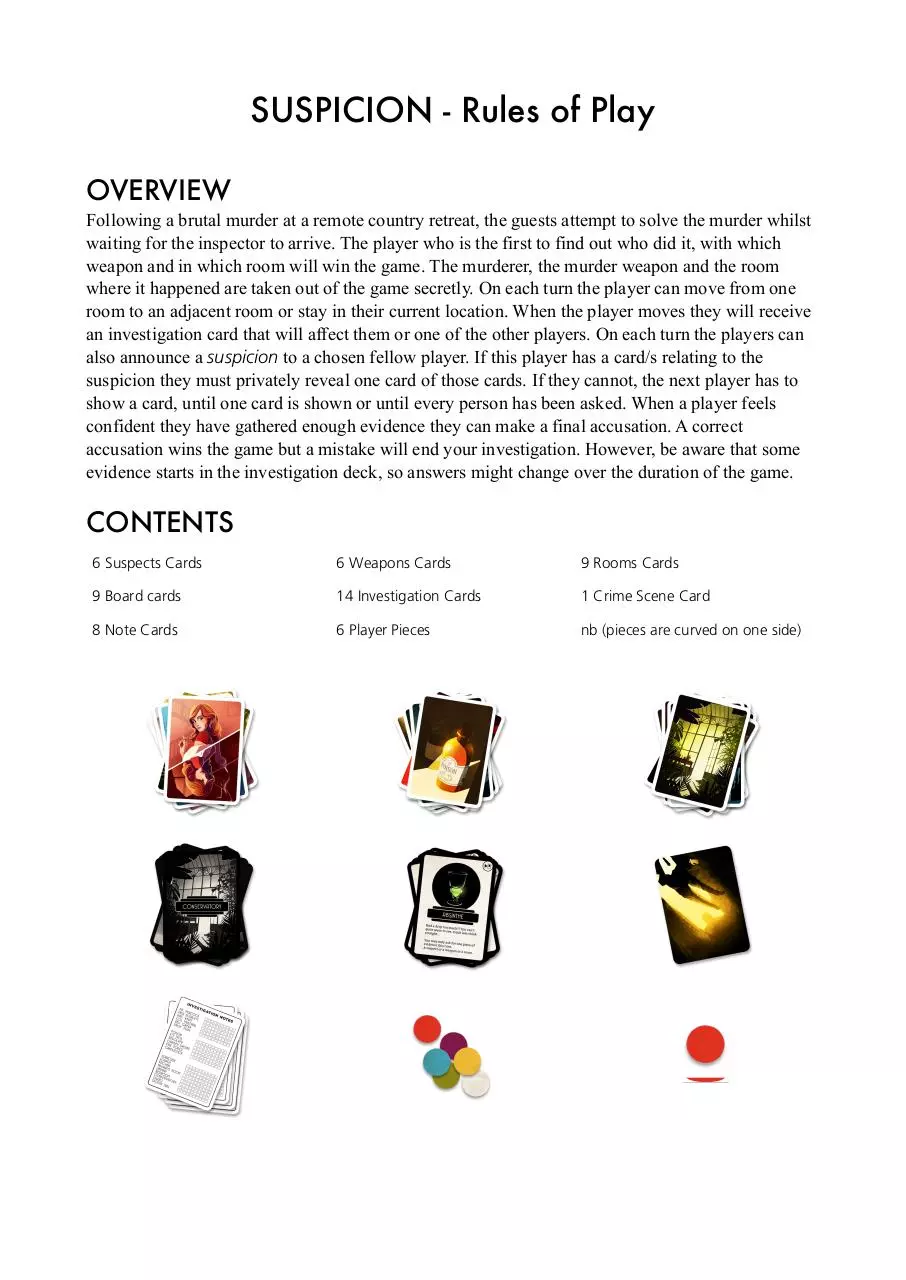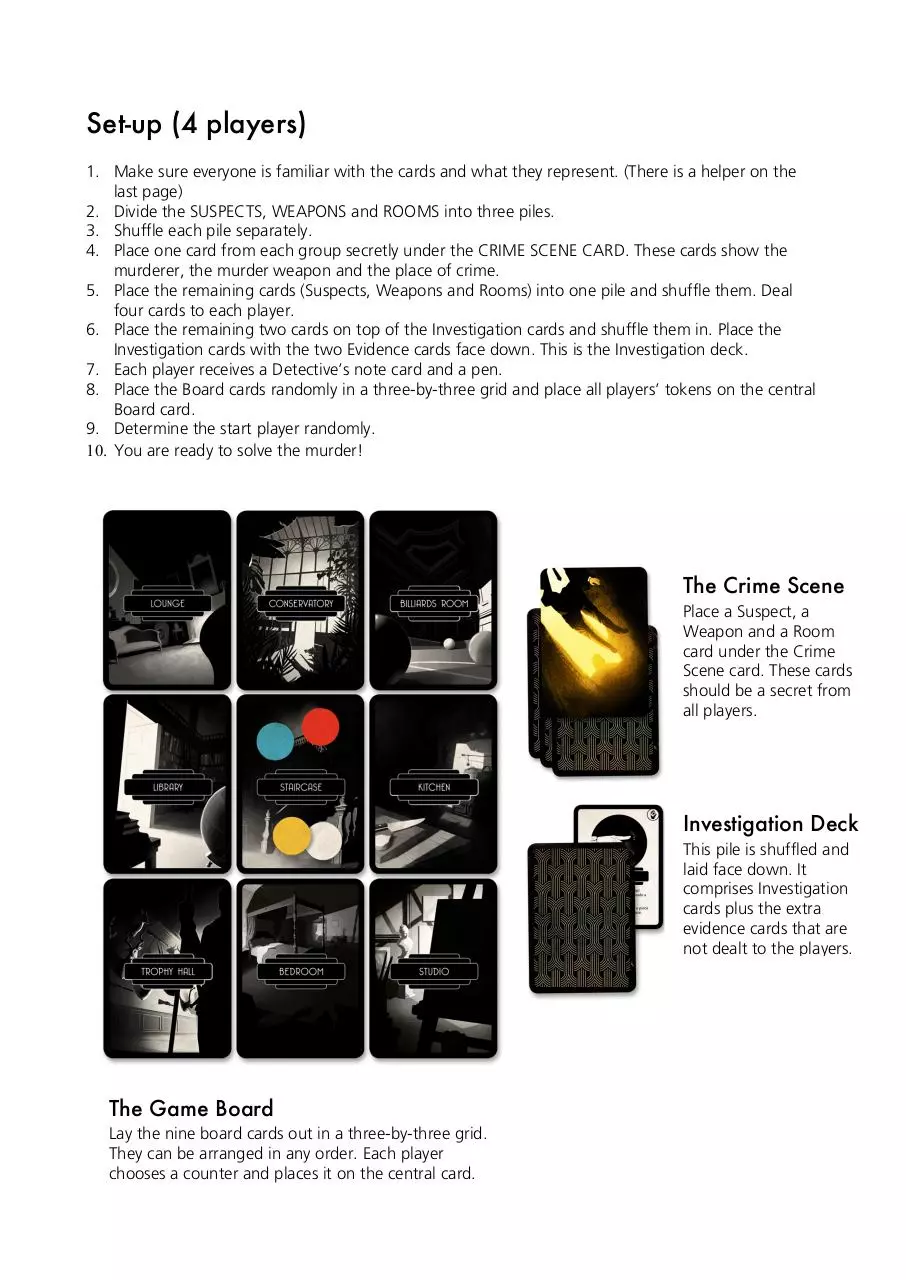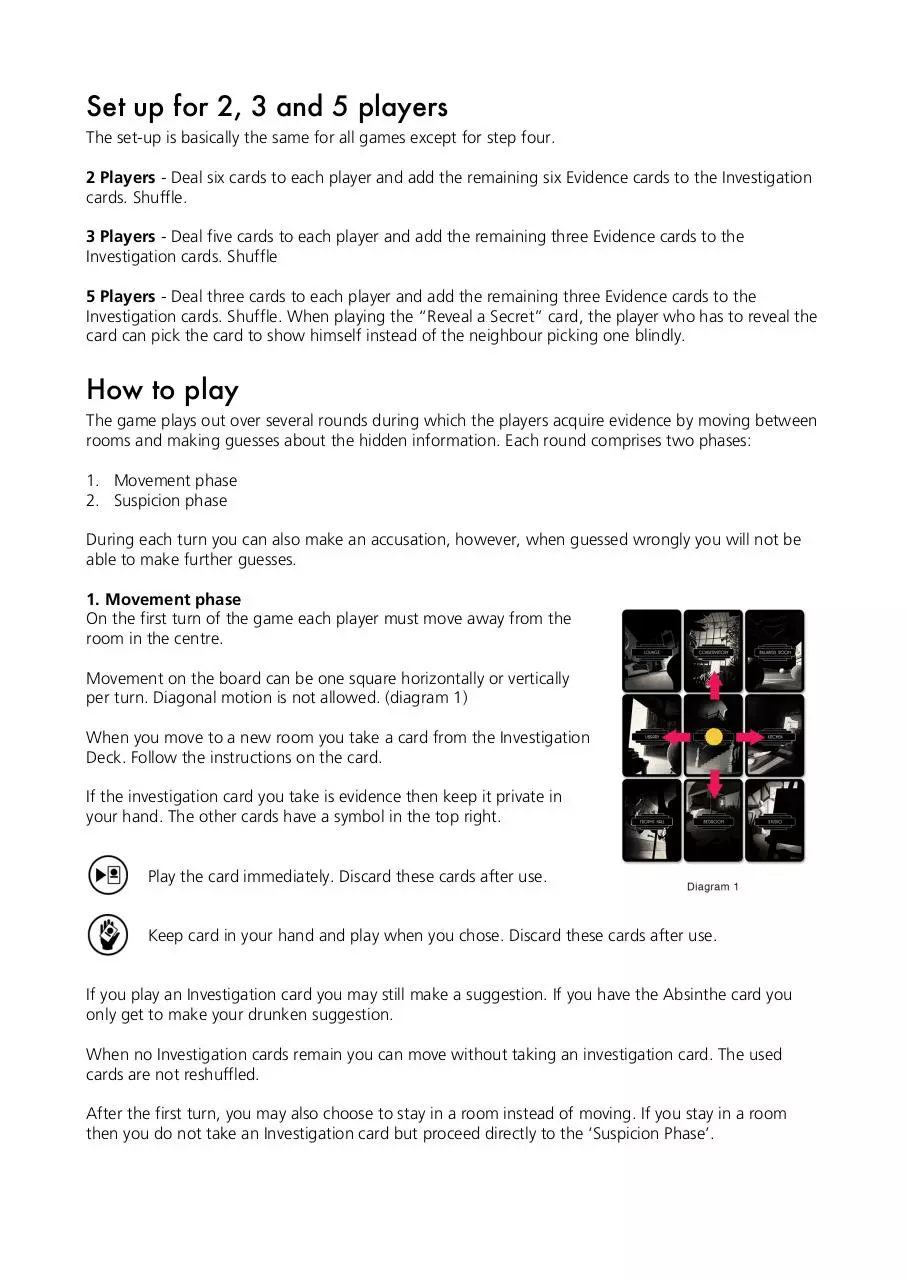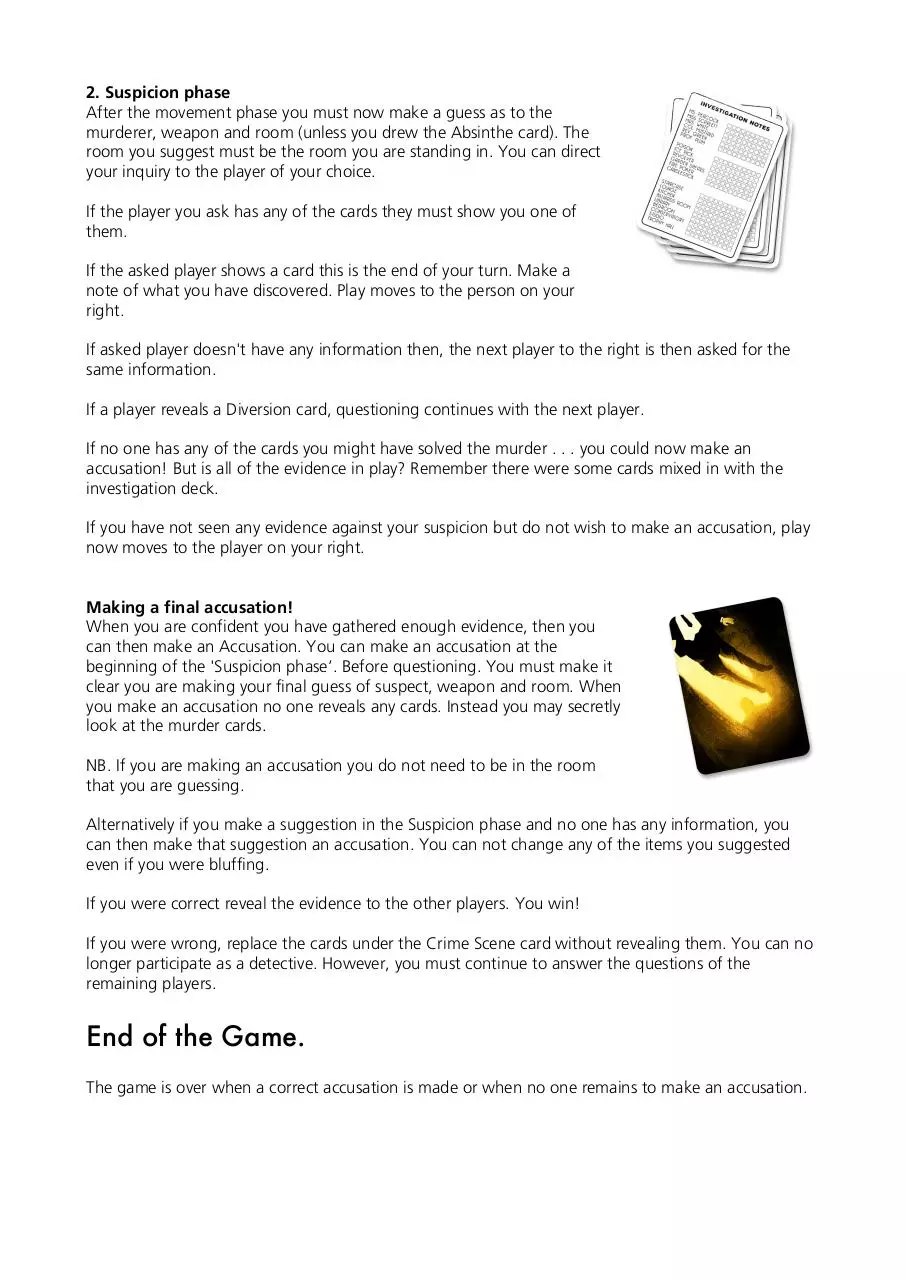Suspicion Rules local (PDF)
File information
Title: Suspicion Rules local
This PDF 1.3 document has been generated by Pages / Mac OS X 10.10.4 Quartz PDFContext, and has been sent on pdf-archive.com on 24/05/2016 at 11:24, from IP address 104.238.x.x.
The current document download page has been viewed 742 times.
File size: 11.95 MB (8 pages).
Privacy: public file





File preview
Please note this game is for promotional purposes only and is not for distribution. Only 200 copies were made for clients of Roland the Illustrator
SUSPICION - Rules of Play
OVERVIEW
Following a brutal murder at a remote country retreat, the guests attempt to solve the murder whilst
waiting for the inspector to arrive. The player who is the first to find out who did it, with which
weapon and in which room will win the game. The murderer, the murder weapon and the room
where it happened are taken out of the game secretly. On each turn the player can move from one
room to an adjacent room or stay in their current location. When the player moves they will receive
an investigation card that will affect them or one of the other players. On each turn the players can
also announce a suspicion to a chosen fellow player. If this player has a card/s relating to the
suspicion they must privately reveal one card of those cards. If they cannot, the next player has to
show a card, until one card is shown or until every person has been asked. When a player feels
confident they have gathered enough evidence they can make a final accusation. A correct
accusation wins the game but a mistake will end your investigation. However, be aware that some
evidence starts in the investigation deck, so answers might change over the duration of the game.
CONTENTS
6 Suspects Cards
6 Weapons Cards
9 Rooms Cards
9 Board cards
14 Investigation Cards
1 Crime Scene Card
8 Note Cards
6 Player Pieces
nb (pieces are curved on one side)
Set-up (4 players)
1. Make sure everyone is familiar with the cards and what they represent. (There is a helper on the
last page)
2. Divide the SUSPECTS, WEAPONS and ROOMS into three piles.
3. Shuffle each pile separately.
4. Place one card from each group secretly under the CRIME SCENE CARD. These cards show the
murderer, the murder weapon and the place of crime.
5. Place the remaining cards (Suspects, Weapons and Rooms) into one pile and shuffle them. Deal
four cards to each player.
6. Place the remaining two cards on top of the Investigation cards and shuffle them in. Place the
Investigation cards with the two Evidence cards face down. This is the Investigation deck.
7. Each player receives a Detective’s note card and a pen.
8. Place the Board cards randomly in a three-by-three grid and place all players’ tokens on the central
Board card.
9. Determine the start player randomly.
10. You are ready to solve the murder!
The Crime Scene
Place a Suspect, a
Weapon and a Room
card under the Crime
Scene card. These cards
should be a secret from
all players.
Investigation Deck
This pile is shuffled and
laid face down. It
comprises Investigation
cards plus the extra
evidence cards that are
not dealt to the players.
The Game Board
Lay the nine board cards out in a three-by-three grid.
They can be arranged in any order. Each player
chooses a counter and places it on the central card.
Set up for 2, 3 and 5 players
The set-up is basically the same for all games except for step four.
2 Players - Deal six cards to each player and add the remaining six Evidence cards to the Investigation
cards. Shuffle.
3 Players - Deal five cards to each player and add the remaining three Evidence cards to the
Investigation cards. Shuffle
5 Players - Deal three cards to each player and add the remaining three Evidence cards to the
Investigation cards. Shuffle. When playing the “Reveal a Secret” card, the player who has to reveal the
card can pick the card to show himself instead of the neighbour picking one blindly.
How to play
The game plays out over several rounds during which the players acquire evidence by moving between
rooms and making guesses about the hidden information. Each round comprises two phases:
1. Movement phase
2. Suspicion phase
During each turn you can also make an accusation, however, when guessed wrongly you will not be
able to make further guesses.
1. Movement phase
On the first turn of the game each player must move away from the
room in the centre.
Movement on the board can be one square horizontally or vertically
per turn. Diagonal motion is not allowed. (diagram 1)
When you move to a new room you take a card from the Investigation
Deck. Follow the instructions on the card.
If the investigation card you take is evidence then keep it private in
your hand. The other cards have a symbol in the top right.
Play the card immediately. Discard these cards after use.
Keep card in your hand and play when you chose. Discard these cards after use.
If you play an Investigation card you may still make a suggestion. If you have the Absinthe card you
only get to make your drunken suggestion.
When no Investigation cards remain you can move without taking an investigation card. The used
cards are not reshuffled.
After the first turn, you may also choose to stay in a room instead of moving. If you stay in a room
then you do not take an Investigation card but proceed directly to the ‘Suspicion Phase’.
2. Suspicion phase
After the movement phase you must now make a guess as to the
murderer, weapon and room (unless you drew the Absinthe card). The
room you suggest must be the room you are standing in. You can direct
your inquiry to the player of your choice.
If the player you ask has any of the cards they must show you one of
them.
If the asked player shows a card this is the end of your turn. Make a
note of what you have discovered. Play moves to the person on your
right.
If asked player doesn't have any information then, the next player to the right is then asked for the
same information.
If a player reveals a Diversion card, questioning continues with the next player.
If no one has any of the cards you might have solved the murder . . . you could now make an
accusation! But is all of the evidence in play? Remember there were some cards mixed in with the
investigation deck.
If you have not seen any evidence against your suspicion but do not wish to make an accusation, play
now moves to the player on your right.
Making a final accusation!
When you are confident you have gathered enough evidence, then you
can then make an Accusation. You can make an accusation at the
beginning of the 'Suspicion phase’. Before questioning. You must make it
clear you are making your final guess of suspect, weapon and room. When
you make an accusation no one reveals any cards. Instead you may secretly
look at the murder cards.
NB. If you are making an accusation you do not need to be in the room
that you are guessing.
Alternatively if you make a suggestion in the Suspicion phase and no one has any information, you
can then make that suggestion an accusation. You can not change any of the items you suggested
even if you were bluffing.
If you were correct reveal the evidence to the other players. You win!
If you were wrong, replace the cards under the Crime Scene card without revealing them. You can no
longer participate as a detective. However, you must continue to answer the questions of the
remaining players.
End of the Game.
The game is over when a correct accusation is made or when no one remains to make an accusation.
Additional notes to investigation cards
Reveal a secret: The next player picks a card blindly that he shows openly to everyone. After you
have shown your card to the other players, you can place it back in your hand.
Diversion: The diversion card is shown openly to everyone. When a diversion card is shown, the
questionnaire continues with the next player.
Download Suspicion Rules local
Suspicion Rules local.pdf (PDF, 11.95 MB)
Download PDF
Share this file on social networks
Link to this page
Permanent link
Use the permanent link to the download page to share your document on Facebook, Twitter, LinkedIn, or directly with a contact by e-Mail, Messenger, Whatsapp, Line..
Short link
Use the short link to share your document on Twitter or by text message (SMS)
HTML Code
Copy the following HTML code to share your document on a Website or Blog
QR Code to this page

This file has been shared publicly by a user of PDF Archive.
Document ID: 0000376070.